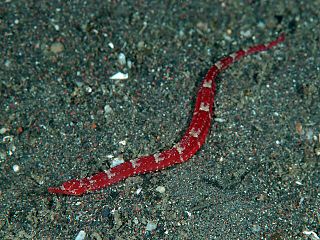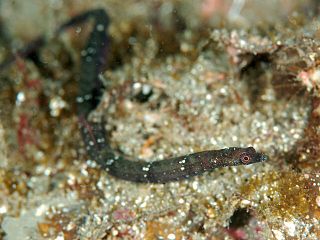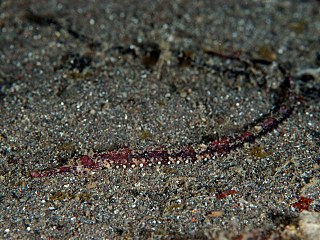Hippichthys cyanospilos, commonly known as the blue spotted pipefish or bluespeckled pipefish, is a marine fish belonging to the family Syngnathidae, native from the Indo-Pacific area.
Cosmocampus heraldi is a species of marine fish of the family Syngnathidae. It is known from only seven specimens, which were found at the Desventuradas and Juan Fernandez Islands in Chile. It inhabits rocky reefs and sandy areas at depths of 6–23 metres (20–75 ft), where it can grow to lengths of 7 centimetres (2.8 in). It is expected to feed on small crustaceans like other pipefish. This species is ovoviviparous, with males carrying eggs until giving birth to live young.
Cosmocampus howensis is a species of marine fish of the family Syngnathidae. It is found in the South Pacific from Jervis Bay to Easter Island. It lives in lagoons and on rocky reefs, where it grows to lengths of 10–12 centimetres (3.9–4.7 in). It is expected to feed on small crustaceans, similar to other pipefishes. This species is ovoviviparous, with males carrying eggs before giving birth to live young.

Dunckerocampus multiannulatus is a species of marine fish of the family Syngnathidae. It is widespread in the Indian Ocean, from the Red Sea and South Africa to the Andaman Islands and Sumatra, Indonesia. It inhabits coral and rocky reefs to depths of 45 metres (148 ft), where it can grow to lengths of 18 centimetres (7.1 in). It is an active cleaner, feeding on small crustaceans that grow on other fishes. This species is ovoviviparous, with males carrying eggs and giving birth to live young. Males may brood at 13 centimetres (5.1 in).

Festucalex erythraeus, known commonly as the red pipefish, is a species of marine pipefish of the family Syngnathidae. It is found throughout the Indo-Pacific, from Mozambique and South Africa to Hawaii, Honshu (Japan), and New Caledonia. It lives among rubble and coral or rocky reefs at depths of 18–40 metres (59–131 ft), where they can grow to lengths of 10 centimetres (3.9 in). They are expected to feed on small crustaceans, such as gammarid shrimps, mysids, and harpacticoid copepods. This species is ovoviviparous, with males brooding eggs and giving birth to live young. Males may brood at lengths of around 5.5 centimetres (2.2 in). It is exported from Hawaii as part of the aquarium trade.

Booth's pipefish is a species of marine fish of the family Syngnathidae. It is found in the Western Indian Ocean, in South Africa and the Comoro Islands, and in the Western Pacific, from South Korea and Japan to the Great Barrier Reef and Tonga. It lives in rocks and coral reefs to depths of 30 metres (98 ft), where it can grow to lengths of 17.5 centimetres (6.9 in). This species is ovoviviparous, with males carrying eggs and giving birth to live young.
Gray's pipefish, also known as the mud pipefish or spiny pipefish is a species of marine fish of the family Syngnathidae. It is found in the Indo-Pacific in the Gulf of Aden, Sri Lanka, and from the Gulf of Thailand to Japan, the Marshall Islands, and the Great Barrier Reef. It lives to depth of 100 metres (330 ft), and planktonic juveniles have been found above depths of 3,000 metres (1.9 mi). It occurs in muddy habitats, in estuaries, and on coral reefs, where it likely feeds on small crustaceans. It can grow to lengths of 20 centimetres (7.9 in). This species is ovoviviparous, with males carrying eggs in a brood pouch before giving birth to live young.

The starry pipefish is a species of marine fish of the family Syngnathidae. It is endemic to Japan, found near Honshu, Kyushu, and Okinawa, where it lives in open sandy areas near reefs. It can grow to lengths of 17 centimetres (6.7 in). It is expected to feed on small crustaceans, similar to other pipefish. This species is ovoviviparous, with males carrying eggs before giving birth to live young. Males may brood at around 10 centimetres (3.9 in).
The spinysnout pipefish is a species of marine pipefish of the family Syngnathidae. It is found in the Indo-Pacific, from Sri Lanka to Samoa, and from Japan and the Marshall Islands to central Australia. It lives in rocky and coral reefs, rubble, lagoons and intertidal zones, often at depths of 2–12 metres (6.6–39.4 ft), where it can grow to lengths of 12 centimetres (4.7 in). It is expected to feed on small crustaceans, similar to other pipefish. This species is ovoviviparous, with males carrying eggs in a brood pouch before giving birth to live young.
Lissocampus bannwarthi is a species of marine pipefish belonging to the family Syngnathidae.

Lissocampus caudalis, also called the Australian smooth pipefish or the smooth pipefish, is a species of marine fish belonging to the family Sygnathidae.
Microphis insularis, also known as the Andaman pipefish, is a species of freshwater pipefish belonging to the family Sygnathidae. This species is found only in rivers and streams located in the Andaman Islands, India. They can reach 16 cm (6.3 in) in length and reproduce through ovoviviparity, in which males carry eggs and give live birth. The Andaman pipefish is considered threatened likely due to the effects of habitat degradation, invasive species, and the alteration of flow of its freshwater habitats.
Maroubra perserrata, also known as the sawtooth pipefish is a species of marine fish belonging to the family Syngnathidae. This species can be found at depths up to 20 meters along the coast of Australia from southern Queensland to southern Western Australia. While they can live in many different habitats, they are often found inhabiting openings in reefs and rocks that contain algae and invertebrates, which they likely rely on for camouflage. Reproduction occurs through ovoviviparity in which the males brood eggs for roughly 22 days before giving live birth. Maroubra perserrata is considered more mobile than many pipefish species due to its prehensile tail and reduced caudal fin.
Phoxocampus diacanthus, also known as the obscure pipefish or spined pipefish, is a species of marine fish belonging to the family Sygnathidae. It can be found inhabiting reefs throughout the Indo-Pacific from Japan and Sri Lanka to Samoa and New Caledonia in the south. Its diet likely consists of small crustaceans. Reproduction occurs through ovoviviparity in which the males brood eggs before giving live birth.
Phoxocampus tetrophthalmus, the trunk-barred pipefish, is a species of marine fish belonging to the family Syngnathidae. This species can be found in reefs and tide pools of the Indo-Pacific specifically Indonesia, the Philippines, and Guam. They have also been observed in the Andaman, Cocos-Keeling, and Ryukyu islands. Their diet likely consists of small crustaceans Reproduction occurs through ovoviviparity in which the males brood eggs before giving live birth.
Stigmatopora nigra, also known as the wide-bodied pipefish is a species of marine fish belonging to the family Syngnathidae. This species can be found in the shallow waters, bays, and estuaries of southern Australia from Shark Bay to Brisbane, Tasmania, and New Zealand. They often inhabit seagrass or algae beds in addition to bare sand. Their diet consists of small crustaceans such as copepods and amphipods. Adult brooding males have been measured at 6.5-7 centimeters. Reproduction occurs through ovoviviparity. in which the males brood up to 25 eggs in a pouch below the tail before giving live birth. Stigmatopora nigra can live to 150 days old and are able to reproduce throughout the year.

Trachyrhamphus bicoarctatus, also known as the double-ended pipefish is a species of marine fish belonging to the family Syngnathidae. They can be found in reefs, seagrass beds, and sandy habitats throughout the Indo-Pacific from East Africa to New Caledonia and from Japan to Australia. Males of this species are considered mature when they reach approximately 26 centimeters long, but adults can grow to be lengths of 40 centimeters. Reproduction occurs through ovoviviparity in which males brood eggs before giving live birth.
Trachyrhamphus longirostris, also known as the long-head pipefish or straightstick pipefish, is a species of marine fish belonging to the family Syngnathidae. They can be found in muddy estuaries on the continental shelf throughout the Indo-Pacific from Eastern Africa to the Solomon Islands and Japan. The diet of Trachyrhamphus longirostris likely consists of small crustaceans. Adult individuals can grow to be approximately 33 centimeters in length. Reproduction occurs through ovoviviparity in which males brood eggs before giving live birth.
Nannocampus weberi, also known as the reef-flat pipefish, is a species of marine fish belonging to the family Syngnathidae. They can be found inhabiting reefs in the Lesser Sunda Islands of Indonesia particularly the islands of Sumba and Bali. Their diet likely consists of small crustaceans such as copepods. Reproduction occurs through ovoviviparity in which the males brood eggs before giving live birth.

Vanacampus phillipi, also known as the Port Phillip pipefish, is a species of marine fish belonging to the family Syngnathidae. They can be found inhabiting seaweed and seagrass beds along the southern coast of Australia from Perth to Jervis Bay, New South Wales including the coast of Tasmania. Their diet consists of small crustaceans such as copepods, amphipods, and mysid shrimps. Reproduction occurs through ovoviviparity in which the males brood eggs before giving live birth to 50 or less offspring.








